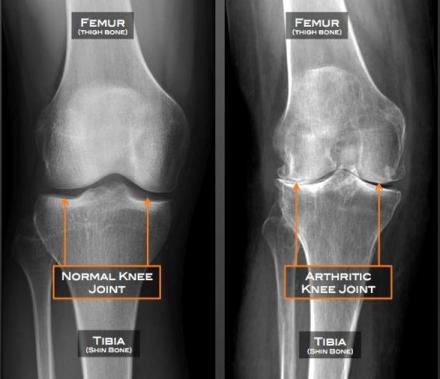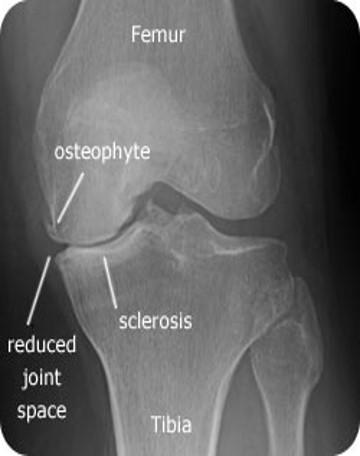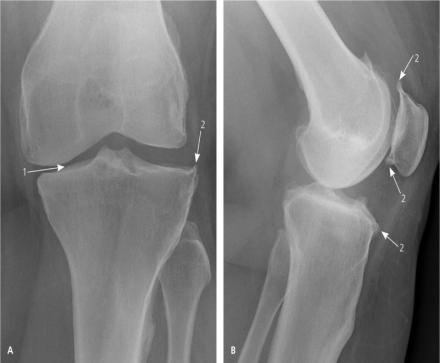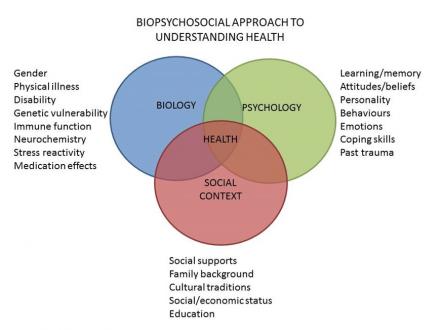Joyce’s Tells her Story of Knee Pain since College
Joyce’s First Meeting with Primary Care Practitioner (PCP)
Pain History
- Location of pain
- Mode of onset
- Severity of pain
- Quality or nature of pain
- Duration and chronicity
- Provocative and relieving factors
- Timing of pain
- Associated complaints
PQRST Mnemonic
P - Provokes
Q – Quality
R – Radiation
S – Severity
T - Timing
Physical Exam
- Inspection and active/passive ROM
- Palpation and assess for effusions
- Special tests unique to the knee
- Bulge sign
- McMurray
- Anterior drawer sign
- Lachman test
Oxford University Medical School. Knee Examination - Orthopedics
Osteoarthritis (OA): Risk Factors
- Age
- Risk increases with age.
- Sex
- Women are more likely to develop OA
- Obesity
- Added stress on weight-bearing joints
- Fat tissue produces proteins that may cause inflammation
- Joint Injuries
- Example: from playing sports or from an accident
- Certain occupations
- Especially if it requires repetitive stress on a particular joint
- Genetics
- Bone deformities
- Other diseases
- Diabetes, gout, rheumatoid arthritis (RA)
Diagnosis of Knee Osteoarthritis
- Joint pain, stiffness and swelling related to underlying anatomical changes
- Damage of articular cartilage
- Osteophyte formation
- Sclerosis of subchondral bone
- Subchondral cysts
- Plain radiographs are often adequate to confirm this diagnosis
Reference
Lespasio MJ, Piuzzi NS, Husni ME, et al. Knee osteoarthritis: A primer. Perm J 2017; doi: 10.7812/TPP/16-183.
Normal and Arthritic Knee X-Rays

Joint Physiology - Osteoarthritis (OA)

The levels of proinflammatory cytokines, including IL-1β, TNF and IL-6, are elevated in OA. These cytokines contribute to the pathogenesis of OA through several mechanisms, including downregulation of anabolic events and upregulation of catabolic and inflammatory responses, effects that result in structural damage to the OA joint. Abbreviations: ADAMTS, a disintegrin-like and metalloproteinase with thrombospondin type 1 motifs; IL, interleukin; MMP, matrix metalloproteinase; OA, osteoarthritis; TNF, tumor necrosis factor.
Reference
Kapoor M, Matel-Pelletier J, Lajeunesse D, et al. Cytokines in the pathophysiology of osteoarthritis. Nature Reviews Rheumatology 2011; 7:33-42
Radiological Findings
Radiological findings consistent with osteoarthritis:
- Joint space narrowing
- Sclerosis of bone around the joint as evidenced by increased opacity of the bone seen on x-ray
- Osteophyte formation seen as opacified connective tissue around the joint

More images of knee osteoarthritis:

Osteoarthritis (OA) Pathophysiology
- Multifactorial and variable. Common contributing factors include:
- Mechanical factors (obesity, history of joint trauma)
- Genetic disposition
- Joint integrity
- Cellular and biochemical factors (inflammation)
- Under normal conditions the joint matrix is subjected to a dynamic remodeling process
- low levels of degradative and synthetic enzyme activities are balanced
- the volume of cartilage is maintained
- In OA cartilage, however, matrix degrading enzymes are overexpressed, shifting this balance in favor of net degradation
- Various cytokines (IL-1, TNF-α) stimulate the production of metalloproteinases
- Metalloproteinases degrade cartilage and also inhibit the production of collagen and matrix
References
Lespasio MJ, Piuzzi NS, Husni ME, et al. Knee osteoarthritis: A primer. Perm J 2017; doi: 10.7812/TPP/16-183.
Ling SM, Bathon JM, Johns Hopkins Arthritis Center. Osteoarthritis: Pathophysiology.
Outpatient Treatment of Osteoarthritis
- NSAIDs
- Acetaminophen
- Ice and rest for acute flares of pain
- Physical Therapy
- Acupuncture
- Opioids are usually avoided in lieu of more conservative treatments
Reference
Lespasio MJ, Piuzzi NS, Husni ME, et al. Knee osteoarthritis: A primer. Perm J 2017; doi: 10.7812/TPP/16-183.
Opioid Risk Assessment
- Many tools are available including ORT, SOAPP and DIRE
- Most important risk factors to consider
- Prior history of addiction
- Family history of addiction
- History of abuse or trauma
- History of mood disorders or other serious psychiatric problems
Joyce’s First Meeting with Health Psychologist
Primary Care Behavioral Health
- Primary Care Behavioral Health (PCBH): model of care to optimize access to behavioral health support within the primary care environment.
- Behavioral health professionals, often called Behavioral Health Consultants (BHCs) or Behavioral Health Specialists, work alongside medical providers in real time.
- On follow-up visits, the patient may see both providers or only one, depending on the situation and need.
- BHCs can provide support for mental health concerns such as depression or anxiety, or physical health concerns such as management of pain, diabetes, hypertension or sleep problems.
- The central goals of the PCBH model are to:
- improve access to care (because referral to specialists from primary care is difficult)
- support the interventions of the medical care team.
- Evidence for the effectiveness of the PCBH model exists.
Integrated Care: Primary Care Behavioral Health (PCBH)

Behavioral Health Providers in Primary Care
- Providers with all types of mental health licenses work in integrated care settings, including medical family therapists, master’s level professionals, social workers and psychologists.
- In addition, care managers, who can have a bachelor’s degree, nursing degree or a master’s degree, play important roles as part of the integrated care team. They typically:
- Manage patient registries
- Provide telephone and in-person support to patients to ensure they don’t fall through the cracks of follow-up care.
Initial Encounters with the Patient
- Meet and greet appointments are initial meetings between behavioral health providers and prospective patients, to establish fit between patient needs and the provider’s scope of practice.
- A “warm-hand-off” occurs when a PCP introduces a patient to another provider during a PCP visit.
PCBH Techniques: Assess Psychological Symptoms that Influence Pain
- Interview gathers information about:
- Current and past stress (including in childhood)
- Amount of personal time available for self-care
- Assess coping skills
- Assess comorbid psychological conditions that could have presented before or after injury and persistent pain
- In this case, a GAD-7 (Generalized Anxiety Disorder 7-item scale) was used to assess anxiety symptoms and need for behavioral health services
- Other screeners are used to screen for depression and substance use
GAD-7
Generalized Anxiety Disorder 7-item (GAD-7) scale
- Over the last 2 weeks, how often have you been bothered by the following problems?
- Not at all sure
- Several days
- Over half the days
- Nearly every day
- Feeling nervous, anxious, or on edge 0 1 2 3
- Not being able to stop or control worrying 0 1 2 3
- Worrying too much about different things 0 1 2 3
- Trouble relaxing 0 1 2 3
- Being so restless that it's hard to sit still 0 1 2 3
- Becoming easily annoyed or irritable 0 1 2 3
- Feeling afraid as if something awful might happen 0 1 2 3
- Add the score for each column
- Total Score (add your column scores) =
- If you checked off any problems, how difficult have these made it for you to do your work, take care of things at home, or get along with other people?
- Not difficult at all
- Somewhat difficult
- Very difficult
- Extremely difficult
Reference
Spitzer RL, Kroenke K, Williams JB, Lowe B. A brief measure for assessing generalized anxiety disorder: the GAD-7. Arch Intern Med 2006;166(10):1092-1097.
Importance of the Biopsychosocial Model
An interdisciplinary model for healthcare that explains the development of illness as a complex interaction of biological factors, psychological factors, and social factors.

References
- Engel GL. The need for a new medical model: A challenge for biomedicine. Science 1977; 196:129–136.
- Borrell-Carrio F, Suchman AL, Epstein RM. The Biopsychosocial Model 25 years later: Principles, practice, and scientific inquiry. Ann Fam Med 2004; 2(6):576–582. doi: 10.1370/afm.245

